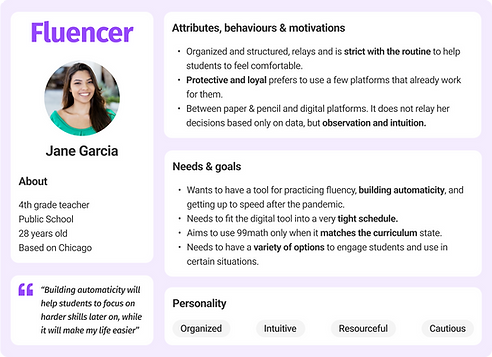
99MATH
CASE STUDY: UNDERSTANDING USERS FOR IMPROVING RETENTION
99math is a fast-paced ed-tech startup developing a game-based math platform for elementary schools in the US. I worked as a user researcher and UX/UI designer to help understand their users’ needs and help remove the blockers to improve user retention.
Type of work: Design research and UX/UI design
Project length: 2 months.
The challenge
As a growth strategy, 99math developed new product features aiming to extend product usage. However, they realized later that they were not being used as expected, and the teachers were not returning to the platform for additional sessions.
The challenge was to create an understanding of 99math users' needs and motivations, identify opportunities for improvements and provide low-cost and quick solutions for some of them.
The solution
After research, it was proposed a ladder of engagement for the user personas aimed to provide different values and journeys for each of them.
However, due to the project length, the scope was a series of improvements on the general user journey for triggering the use of the assignment option, as the research showed that independent practice was preferred by teachers.
RESEARCH
More than 1.5 teachers people play 99math. From helping their students to get math automaticity to bringing excitement to their classes, they have a diverse set of needs. In addition to being a free and fun educational app, we wanted to better understand the users' current workflows and pain points to provide better experiences, but mostly for making sure we were bringing value to all of them.
As was expected in a startup environment, there was not much information to create a knowledge base, but the information was in the founders’ minds and the design archive. Therefore, my first task was to build an understanding of the field based on their experiences and hypothesis, for later to propose and execute a variety of research methods. My role also included the research planning and operations, as the analysis of findings:
-
Online surveys for asking general questions and filtering target users.
-
Semi-structured in-depth interviews to understand better users’ needs, expectations, and motivations.
-
Contextual Inquiry to uncover hidden insights about customers’ work through observation.
-
Competitive Analysis.
1. Interviews & Survey
Through semi-structured in-depth interviews, we gained an initial understanding of the target user’s motivations, goals, and barriers to use 99math.
Motivations: Three major motivations and goals for using 99math
Creating excitement
Improving facts automaticity
Using flex time wisely
Barriers: Four major barriers and sources of discomfort during 99math usage

2. Personas
The first research outcome was the creation of personas to help the company to understand better the different users they have. I presented 3 types of personas that were validated by interviewees later on.



These personas were identified based on users’ behaviors and motivations, and proposed as a ladder of engagement, understanding that users enter 99math with different mindsets and objectives, but these can be transformed over time.
While Rewarders, Fluencers, and Reviewers are current users, the Recommenders are a new category. They are the advocates who can help to spread the word, being an articulator with students, parents, and other teachers and almost be part of the team.

3. Competitive Analysis
The competitive analysis of current industry leaders was run based on the categories detected as important after users interviews.




Based on the analysis above, it was possible to perceive some recommendations for the company to improve adoption.
Core standards and alignment: Being able to align content with the most popular curriculums will help to improve teachers’ trust and increase usage frequency.
The balance between gamification and math practice: Games, tokens, and avatars seem to be a good strategy for students’ engagement, but not exactly for teachers. Keeping attention in math practice is key to gaining adults’ (purchase decision-makers) adoption.
The assignment is prefered: Platforms focus on independent practice over group practice. Since teachers need to ensure each student learns the skills, they prefer to dedicate most of the time to individual practice, meaning that focusing on encouraging assignments in the product is key.
The game does not replace instruction: Platforms with a high level of gamification are mostly dedicated to fluency. Although they have some solutions to support instruction and correction, these are not enough to replace instructional practice.
4. Insights
Teachers prefer assignment
Over group training, teachers give priority to independence practice. This should be fun also!
No need, no explore
If the teacher doesn’t have the need, they won’t find additional features. 99math must create it.
Different journeys
Users have different mindsets and goals, 99math can persuade them about each other values.
99math is for review
Time-based games require previous knowledge, therefore instructional practice cannot be done in 99math
Live game is the best value
99math best feature is the live game. This excitement should be also in the assignment.
Differentiation is key
Individual path and progress rhythm according to performance help students to be engaged
The research showed several gaps and opportunities for improvement. However, due to the time frame and the startup nature of the organization, we needed to select an achievable improvement that represents the most impact in the short possible time.
Therefore, improving the assignment option within the user journey was selected as the scope of the next phase of the project. Leaving the other recommendations for future improvements.

IDEATION
Work in progress...